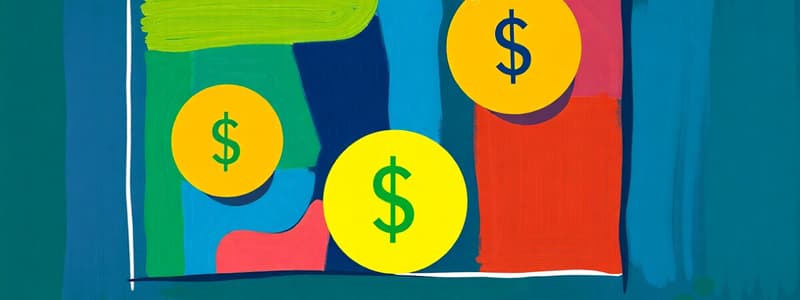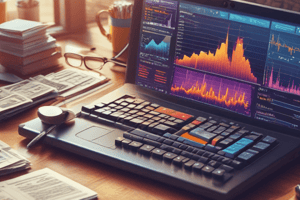Podcast
Questions and Answers
What is the primary purpose of Altman’s Z model?
What is the primary purpose of Altman’s Z model?
- To predict stock market fluctuations
- To assess employee productivity
- To evaluate company credit ratings
- To predict bankruptcy risk (correct)
What is the accuracy of the Z-Score in predicting bankruptcy for the first year?
What is the accuracy of the Z-Score in predicting bankruptcy for the first year?
- 90%
- 85%
- 75%
- 95% (correct)
Which formula component is multiplied by 0.99 in Altman's Z-Score calculation?
Which formula component is multiplied by 0.99 in Altman's Z-Score calculation?
- Sales (correct)
- EBIT
- Market Value of Equity
- Retained Earnings
What does a Z-Score greater than 3.00 indicate about a company like Home Depot?
What does a Z-Score greater than 3.00 indicate about a company like Home Depot?
Which element does NOT directly factor into the calculation of the Z-Score?
Which element does NOT directly factor into the calculation of the Z-Score?
What does a credit analyst primarily assess when determining a credit rating?
What does a credit analyst primarily assess when determining a credit rating?
Which ratio is NOT commonly used by S&P to assess financial risk?
Which ratio is NOT commonly used by S&P to assess financial risk?
What is the anchor credit rating for an issuer with a strong business risk profile and the given metrics?
What is the anchor credit rating for an issuer with a strong business risk profile and the given metrics?
In the context of credit ratings, what does the FFO/DEBT ratio indicate?
In the context of credit ratings, what does the FFO/DEBT ratio indicate?
Which step is least likely part of Moody's credit rating process?
Which step is least likely part of Moody's credit rating process?
What financial leverage ratio is used to evaluate company's debt levels?
What financial leverage ratio is used to evaluate company's debt levels?
Which agency's methodology is referenced for providing a composite rating like bbb+?
Which agency's methodology is referenced for providing a composite rating like bbb+?
What might affect the final credit rating aside from the baseline credit rating?
What might affect the final credit rating aside from the baseline credit rating?
What is the primary feature of a revolving credit line?
What is the primary feature of a revolving credit line?
Which financing option typically requires collateral tied to its useful life?
Which financing option typically requires collateral tied to its useful life?
What characteristics define commercially traded debt?
What characteristics define commercially traded debt?
What is the main objective of credit risk analysis?
What is the main objective of credit risk analysis?
The chance of default mainly relies on what factors?
The chance of default mainly relies on what factors?
Which type of financing typically involves the lender taking property as security?
Which type of financing typically involves the lender taking property as security?
What does expected credit loss represent in the context of lending?
What does expected credit loss represent in the context of lending?
What financial tool is characterized by a commitment to provide funds when required?
What financial tool is characterized by a commitment to provide funds when required?
How does a decrease in stock price typically affect a firm's Distance to Default?
How does a decrease in stock price typically affect a firm's Distance to Default?
What is the effect of a firm refinancing short-term debt with long-term debt on its financial stability?
What is the effect of a firm refinancing short-term debt with long-term debt on its financial stability?
Which factor does NOT influence Loss Given Default (LGD)?
Which factor does NOT influence Loss Given Default (LGD)?
What priority do secured creditors hold under U.S. Bankruptcy Code?
What priority do secured creditors hold under U.S. Bankruptcy Code?
If a firm increases its time horizon for debt repayment from 1 year to 2 years, how does this generally affect its risk?
If a firm increases its time horizon for debt repayment from 1 year to 2 years, how does this generally affect its risk?
What defines the maximum amount that a creditor allows a customer to owe at any given time?
What defines the maximum amount that a creditor allows a customer to owe at any given time?
Which statement is true regarding the treatment of ordinary trade creditors during bankruptcy?
Which statement is true regarding the treatment of ordinary trade creditors during bankruptcy?
How do lenders minimize potential loss during a default situation?
How do lenders minimize potential loss during a default situation?
What is the primary purpose of credit analysis?
What is the primary purpose of credit analysis?
Which of the following is NOT considered a participant in the demand for credit?
Which of the following is NOT considered a participant in the demand for credit?
What type of cash needs do companies experience due to cyclical operating activities?
What type of cash needs do companies experience due to cyclical operating activities?
Which activity requires companies to seek large amounts of cash for investments?
Which activity requires companies to seek large amounts of cash for investments?
What does trade credit typically entail?
What does trade credit typically entail?
What might a willing lender provide that can affect a company's survival?
What might a willing lender provide that can affect a company's survival?
Which of the following is a source of supply for credit analysis?
Which of the following is a source of supply for credit analysis?
What does the term 'LBO' refer to in the context of credit demands?
What does the term 'LBO' refer to in the context of credit demands?
Which of the following describes the cash needs for covering operating losses?
Which of the following describes the cash needs for covering operating losses?
In credit analysis, which of the following represents a demand source for credit?
In credit analysis, which of the following represents a demand source for credit?
Flashcards are hidden until you start studying
Study Notes
Credit Analysis
- Credit analysis is the process of determining a borrower's ability and willingness to meet financial obligations.
- The primary purpose of credit analysis is to evaluate the likelihood of a borrower repaying debt on time and in full.
- Credit risk is the risk of a borrower failing to meet their financial obligations, leading to a loss for the lender.
Demand and Supply of Credit
- The demand for credit comes from various entities such as banks, bond investors, corporations, suppliers, customers, and individuals.
- Suppliers of credit include internal corporate credit teams, bank credit analysis teams, credit rating agencies (S&P, Moody's, Fitch), fixed income research firms, and consulting firms.
- Companies need credit for operating activities like manufacturing, seasonal purchases, and covering operating losses.
- Investing activities such as acquiring property, plant, and equipment, intangible assets, mergers & acquisitions, and leverage buyouts also require credit.
- Financing activities like maturing bank loans or bonds, stock repurchases, and other corporate financing activities can create demand for credit.
- Trade credit, a form of supplier credit, is generally non-interest bearing, with terms specifying early payment discounts, credit limits, payment terms, and other conditions.
- Banks provide various credit facilities, including revolving credit lines for seasonal shortfalls, lines of credit for backup funding, term loans for financing fixed assets, and mortgages for real estate transactions.
- Other forms of financing include lease financing, publicly traded debt (commercial paper, bonds, debentures), and credit rating agency-rated debt.
Credit Risk Analysis Process
- The credit risk analysis process quantifies potential credit losses to inform lending decisions.
- Expected credit loss considers both the debtor's ability to repay and the size of the loss if the debtor defaults.
- The chance of default is determined by a company's ability to repay its obligations, which is a function of future cash flow and profitability.
- Loss Given Default (LGD) is the potential amount lost if a company defaults on its obligations.
- LGD depends on the priority of the claim compared to other existing claims, determined by the U.S. Bankruptcy Code.
- Lenders mitigate potential losses through credit limits, collateral requirements, repayment terms, and covenants.
Credit Rating Analysis
- Credit rating agencies such as Moody's and S&P Global Ratings analyze macroeconomic, industry, and firm-specific information to assess the chance of default and expected payment in the event of default.
- They provide ratings on both debt issues and issuers, aiming to predict loan defaults accurately.
- Moody's 9-step credit rating process involves identifying the issuer, reviewing financial statements, conducting industry analysis, determining the borrower's financial risk, assessing key business risk factors, analyzing financial flexibility, evaluating management, incorporating governance and environmental and social considerations, and determining the rating.
- S&P Global Ratings uses a similar approach, including financial risk assessment with cash flow ratios, leverage ratios, and other metrics.
The Z-Score Model
- Altman's Z-Score model is used to predict bankruptcy risk using various financial ratios.
- The Z-Score considers working capital, retained earnings, EBIT, market value of equity, total assets, and sales.
- A Z-Score above 3.0 suggests low bankruptcy risk in the short term.
Studying That Suits You
Use AI to generate personalized quizzes and flashcards to suit your learning preferences.




